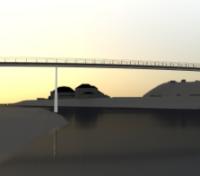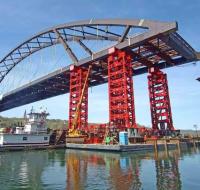Bridges in Lyon and London have been announced as winners of the two bridge categories in the Structural Awards 2015 which are organised by the Institution of Structural Engineers and were celebrated in a ceremony in London last week.
The Pont Schuman Bridge in Lyon, France and the Greenwich Reach swing bridge in south east London won the highway and railway bridge category, and the footbridge category respectively. Both were designed by consultant Flint & Neill.
%20Flint%20&%20Neill.jpg)
Two other pedestrian bridges were commended in what was a hotly-contested category; the Merchant Square Footbridge in London, designed by Knight Architects and AKT II and the Jim Stynes Bridge in Melbourne, Australia, which was designed by Aurecon.
Pont Schuman in Lyon (Flint & Neill)
Pont Schuman is an elegant new crossing of the River Saône in Lyon, France. Designed to ease congestion on the city's existing crossings, the bridge also forms part of an urban re-development, improving the public space along the river and providing a recreational area where pedestrians can enjoy views of the city.
The unusual twisted arches act as the primary structural element, creating a dramatic piece of sculpture with their unique, twisting, gull-wing form. The 120 tonne arches were transported to site by barge, then rotated through 80 degrees and jacked into place.
The judges were impressed by the elegance of the bridge and its slenderness. They particularly noted the high quality of detailing and the technical challenges that had to be overcome in the design and fabrication of the arches.
The bridge was designed by Flint & Neill, working with French architects Explorations Architecture and local engineers AIA. Main contractor for the bridge was GTM, part of the Vinci Group.
%20Simon%20Kennedy%20Moxon.jpg)
Greenwich Reach swing bridge (Simon Kennedy/Moxon)
The Greenwich Reach swing bridge completes a much needed link in the Thames Path, crossing the mouth of Deptford Creek just east of the historic Deptford Royal Dockyard which was established by Henry VIII in 1513 and was where Elizabeth I knighted Francis Drake and Samuel Pepys oversaw construction of the first ships of the modern navy.
It delivers a valued link for local residents to access public transport and local attractions (removing the detour inland that involved using a busy highway crossing). Drive motors rotate the bridge through 110 degrees, swinging it open to allow access for local river traffic. Its design was inspired by modern yachts, reflecting the maritime heritage of the local area.
The judges were impressed by the response to the engineering challenge presented by this site. They commented that the solution has been executed elegantly, creating a lightweight coherent response to a classic bridge form; with respect for its surroundings and future adaptability. The innovative approach allows for clear structural expression of the counter-balance, in contrast with the slender bridge deck, lending this bridge a meticulously engineered aesthetic.
Flint & Neill led the design team, which also included bridge architects Moxon and specialist M&E engineers Eadon Consulting. Client was Galliard Homes, the developer responsible for a large residential and commercial development to the east of the bridge. Main contractor was Raymond Brown Construction, with structural steelwork by SH Structures and M&E works by Qualter Hall.
Two other pedestrian bridges were commended in what was a hotly-contested category; the Merchant Square Footbridge in London, designed by Knight Architects and AKT II and the Jim Stynes Bridge in Melbourne, Australia, which was designed by Aurecon.




